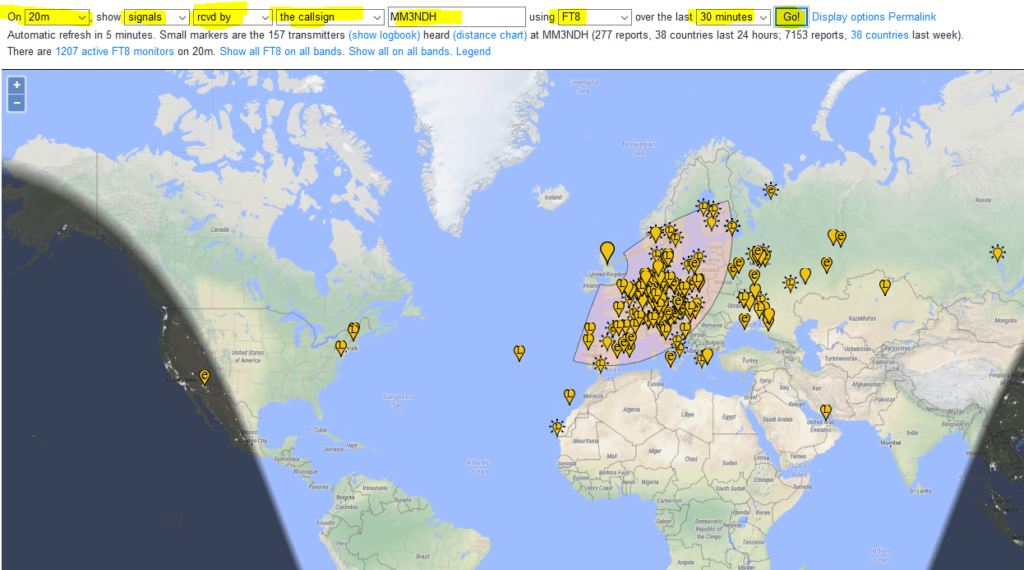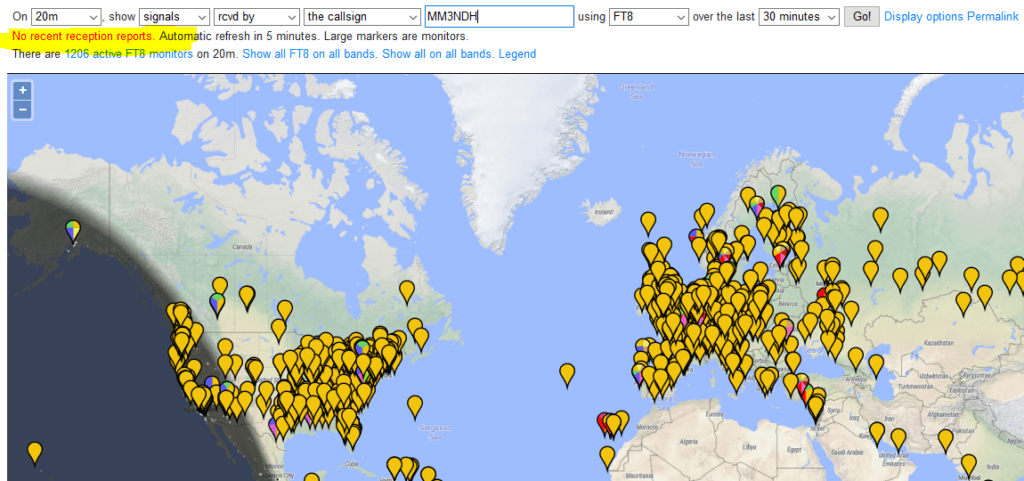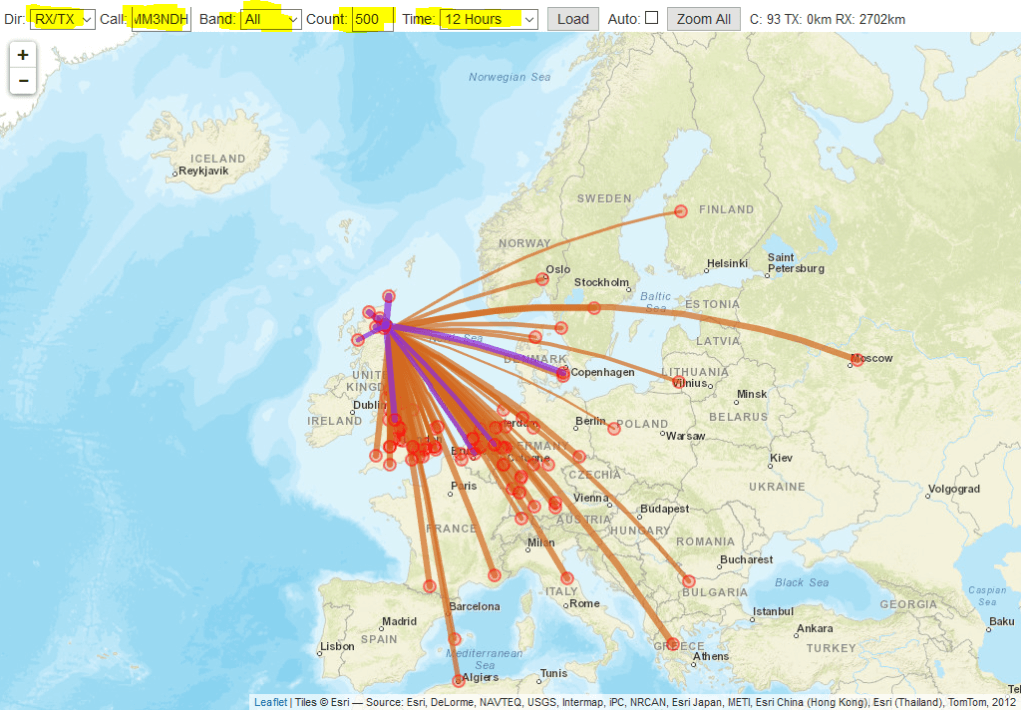At almost 1000 QSOs with FT8 using WSJT-X I thought I’d share a quick set up guide and some tips.

I won’t go into TX here, only RX for now.
1. Get audio from your radio into your computer – obviously can’t describe exactly how as it differs for everyone.
2. Download and run: https://www.physics.princeton.edu/pulsar/k1jt/wsjtx-2.2.2-win64.exe (most recent Windows version at time of writing – likely a newer version available).
3. Open WSJT-X and perform initial configuration. The minimum you have to configure is callsign and grid locator as highlighted here:

Check the correct audo input device is selected in the Audio tab.

Also, ensure spotting in enabled.

That’s the basic configuration. Next we need to check a couple of things.
1) Ensure you computer clock is accurate.
First do a quick NTP sync. Open the ‘Date & Time’ settings for Windows and hit the highlighted button.

Next, go to this site in a browser https://time.is/
At the top it will say how accurate your clock is. Mine is intentionally behind in this example:

In terms of accuracy needed. 0.2 seconds is acceptable and will work perfectly fine. 1.0 seconds is pushing it and 1.5 seconds will cause problems. Of course being as exact as possible is desirable for many reasons.
Next (CAT control ins’t covered here) tune your radio to 14.074 USB (or a different band if you want but 20m is a good start as it’s really busy).
Ensure audio levels are correct. WSJT-X has a level indicator to tell you.
In short, green is good, red is bad.

If you need to adjust this level, you can do it via the unhelpfully named ‘Change system sounds’ Windows settings page.
Under the ‘Recording‘ tab select the properties of the correct input devce and tweak the levels until the indicator in WSJT-X shows green.
Whilst you’re in there, it is worth checking the sampling rate is set to 48000 Hz.(16 bit) – don’t overlook this check as it can prevent decodes.


I’m going to continue to assume you don’t have CAT control configured so next we want to select the mode and band.
From the ‘Mode‘ menu – select FT8
From the band drop down, let’s select 20m.

Ensure the ‘Monitor‘ button is green, if not, click it.

At this point you should be decoding transmissions and see them in the left hand box with some colour coding. The chances are all CQ calls will be purple.
I won’t go any deeper just now but needless to say this is a good starting point. There are two useful things to look out for.
1. The number in the box as shown highlighted below is the number of decodes in the last 15s window.

In that example we see 22 decodes. That is a fairly low amount for 20m. The reason that’s so low is because as I’m writing this I have some lovely QRM. Usually it floats between 45-55 decodes. To be more precise it’s usually around 45 with my Yaesu and 55 with my SDR depending on band conditions and time of day etc etc.
Another thing to be aware of is how signal strengths are calcuated. You will see this represented in dB in the second column in the decode window. (More info here: http://www.arrl.org/forum/topics/view/1957). The noisefloor is relative to the receiving station. Its value is the strength of the Frequency Shift Keying signal (6.25 Hz) compared to the all the signals in the ~2.5 kHz sideband bandwidth. The calculations below show why FT8 signals cannot be below -26db.
SNR = Reported SNR + (10 x LOG (2500 Hz/6.250 Hz))
SNR = Reported SNR + (10 x LOG (400))
SNR = Reported SNR + 26 dB
So, now the cool part. Remember we enabled logging at the beginning? This means we can see our current decodes as well as go back in time. This is really useful for checking current DX conditions and even better how your station is performing.
First up, go to this site in a browser: https://www.pskreporter.info/pskmap.html
Next, fill out the fields as I have here, replacing my call with your own.

When you hit ‘Go‘ it will populate the map with the stations you have decoded in the given time window – showing a yellow marker for each.
Two very important tips:
1) It can take a few minutes for your spots to show as they send in batches. Be patient.
2) Don’t be caught out by the following:

If
you see the red writing ‘No recent reception reports’ it means no data
has been found for what you’ve asked for – check the drop downs and
fields etc. Also again, be patient.
When this happens it populates
the map with all current stations and it’s easy to think you’re
recieving the whole world! Unfortunately that isn’t the case 🙁
Hopefully someone finds this helpful. It obviously doesn’t cover CAT control and TX’ing but I may make another article covering those.
One last tip. If you want to try WSPR, this site is handy for spotting information: http://wspr.aprsinfo.com. Example settings below. Don’t get caught out by not setting ‘Count’ to a high enough value as that limits the number of results returned.

I’m quite new to this but your article is excellent.